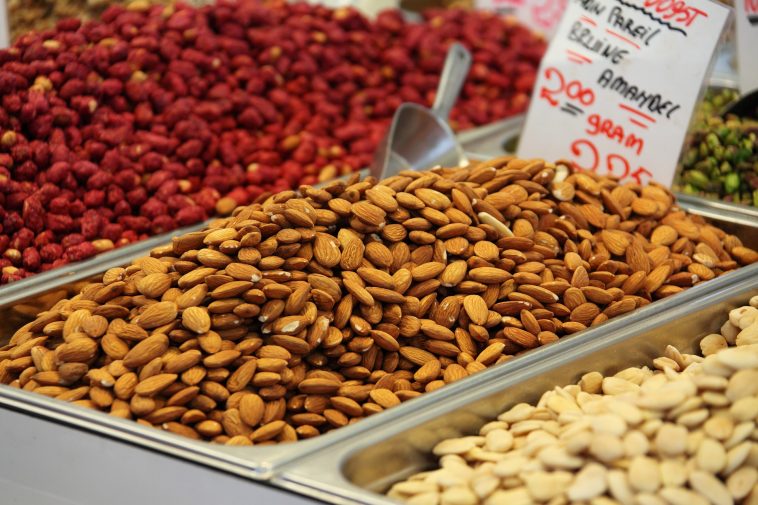Markets in all agricultural systems are best accessed by the supplier fulfilling pre-established requisites.
These requisites help the supplier to meet target market specifications, exploit market opportunities and manage risks. It is thus imperative for tree nut industry participants to understand the sector and stage in which they will contribute to the value addition chain, which can be culinary, cosmetic or medicinal.
The processing of nuts as stated by Clark (2002) begins with similar steps: pre-cleaning, often drying, size separation, cracking (hulling and shelling), air aspiration to separate shell fragments, colour sorting to remove other defects, and a final hand sort and inspection before packaging. This process may not following the specific order above due to varying nut types. Pre-cleaning involves separating nuts and foreign objects by their size and density through gravity and air separation by means of screens and fans. Nuts are first sifted by a screen with a mesh size equal to the desired nut size allowing larger debris to be retained on the screen while nuts and smaller objects fall through. Then, the smaller debris can be screened out by running the material through a second screen with a smaller mesh size.

Industrial nut processing and packaging equipment. (Source: heatandcontrol.com)
The last step is air blowing which removes stems and debris, and separates the lighter particles from the heavier nuts. The proper processing of nuts is essential as almost all tree nuts are composed of a thick and wet hull that wraps the shell and kernel inside at harvest. As the result, freshly harvested tree nuts usually have high initial moisture contents (IMCs) and water activity. Such characteristics make fresh tree nuts vulnerable to spoilage and quality deterioration after harvesting. Therefore, artificial drying is critical to preserve the quality and safety of the nuts. Meanwhile, since tree nuts are rich in unsaturated fatty acids, their oil quality is sensitive to the thermal drying process. Drying methods commonly used are hot air drying (HAD), pulsed vacuum drying (PVD), and radio frequency combined hot air drying (RF-HAD).

HAD involves heat transfer from hot air to the nuts by convection, and evaporated water is transported to the air also by convection. The process promotes preservation of the nuts, thus increasing their shelf life as well. PVD employs successive change of vacuum pressure in the drying chamber to enhance moisture transfer during the drying process. During PVD processing, the pulsed vacuum environment creates an oxygen deficient environment, which can reduce adverse biochemical reactions, such as oxidation deterioration and brown ing reactions, and thereby improve the quality attributes of dried products.
Radio frequency (RF) drying is an effective and practical dielectric drying method due to rapid and volumetric heating, deep penetration and moisture self-balance effects. It employs electromagnetic radiation (EMR), that is the transfer of energy by radio waves. In the case of RF-HAD hot air is combined with RF units to enhance heating uniformity and drying efficiency. Hulling and shelling involves the removal of most of the foreign material attached to the nuts.
There is also an aspiration system that runs in unison with the hulling and shelling machinery to control dust produced during processing. After the nuts have been sterilized, roasted, shelled, and peeled, they must be graded and sorted on the basis of colour and size. As nuts have similar hull-shell-kernel multiplayer structures, the postharvest processing operations, including cleaning, de-hulling and drying, are similar for different types of tree nuts.

However, due to the differences in the shell conditions, moisture contents (MCs) and lipid compositions, the processes have some differences. Consideration of these characteristics during the processing of nuts ensures that tree nuts are appropriately and efficiently handled to ensure the quality, safety, and market value of dried products. The sub-Saharan postharvest industry growth can be aided through the adoption of digital economy innovations. African countries also need to invest more in research and development, and promote the creation of technology and investment hubs where international partners and their governments can offer investment support to create home-grown digital solutions.

References
Clark, J. P. (2002) Processing Tree Nuts. Food Technology Magazine.
Available at: https://www.ift.org/ news-and-publications/food-technology-magazine/issues/2002/june/ columns/processing
Available at: https://www.heatandcontrol.com/blog/nut-processingmethods-and-how-to-create-exciting-and-unique-products
Available at: https://www.pmg.engineering/processing-of-tree-nuts/
Available at: https://www.intechopen.com/chapters/80454
Xie, Y., Lin, Y., Li, X., Yang, H., Han, J., Shang, C., Li, A., Xiao, H., Lu, F. (2022) Peanut drying: Effects of various drying methods on drying kinetic models, physicochemical properties, germination characteristics, and microstructure. Available at: https:// doi.org/10.1016/j.inpa.2022.04.004
Antal, T. (2015) Comparative study of three drying methods: freeze, hot air assisted freeze and infrared-assisted freeze modes. Available at: https://agronomy.emu.ee/ vol134/13_4_1_B5.pdf
Zhang, B., Zheng, A., Zhou, L., Huang, Z. (2016) Developing hot air-assisted radio frequency drying for in-shell walnuts. Available at: https://www.researchgate.net/publication/301249963_Developing_hot_ air-assisted_radio_frequency_drying_for_in-shell_walnuts









